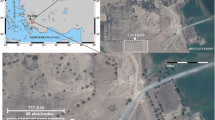Abstract
The workspace as Bouleuterion (parliament house) is located in the ancient city of Alabanda far approximately 7 km from Aydin, Çine. The works on the city plan are still continued by the Department of Archeology in Adnan Menderes University. In this work, a geophysical study based on electrical resistivity tomography (ERT) approach is used to bring out the existence of the buried structures and situations of ruins in Bouleuterion. This study is a good example of implementation of the electrical resistivity method to the archeology in a specific area (Bouleuterion). Furthermore, the paper shows to researchers practically advantages and disadvantages of Wenner and dipole-dipole arrays that widely used in archeological prospection. Also with this work, a Bouleuterion has been subject of a geophysical article for the first time. By archeology and geophysics evaluations, it is proved that these ruins such as the cavea, stage, orchestra, and entrances are parts of the Bouleuterion.









Similar content being viewed by others
References
Aubry L et al. (2001) Recent achievements and trends of research for geophysical prospection of archaeological sites. J Radioanal Nucl Chem 247(3):621–628
Bean, G. E., 1971. Turkey beyond the maeander: an archaeological guide, 180
Bean, G. E., 1976. “Alabanda”, Princeton encyclopedia of classical sites, 133
Candansayar ME, Başokur AT (2001) Detecting small-scale targets by the 2D inversion of two-sided three-electrode data: application to an archaeological survey. Geophys Prospect 49:13–25
Claerbout JF, Muir F (1973) Robust modeling with erratic data. Geophysics 38:826–844
Dahlin T, Zhou B (2004) A numerical comparison of 2D resistivity imaging with 10 electrode arrays. Geophys Prospect 52:379–398
De Domenico D et al. (2006) Integrated geophysical surveys at the archaeological site of Tindari (Sicily, Italy). J Archaeol Sci 33:961–970
Diamanti N et al. (2005) Integrated interpretation of geophysical data in the archaeological site of Europos. Archaeol Prospect 12:79–91
Diamanti N et al. (2013) Geophysical prospection at the Hamza Bey (Alkazar) monument Thessaloniki, Greece. Mediterr Archaeol Archaeometry 13(1):9–20
Dinsmoor WB (1950) The architecture of ancient Greece: an account of its historic development. W. W. Norton Company, London, p. 296
Drahor MG (2006) Integrated geophysical studies in the upper part of Sarris archaeological site, Turkey. J Appl Geophys 59:205–223
Drahor MG et al. (2008) Magnetic and electrical resistivity tomography investigations in a roman legionary camp site (Legio IV Scythica) in Zeugma, Southeastern Anatolia, Turkey. Archaeol Prospect 15:159–186
Drahor MG et al. (2011) Integrated geophysical surveys for the subsurface mapping of buried structure under and surrounding of the Agios Voukolos Church in Izmir, Turkey. J Archaeol Sci 38:2231–2242
Bey E (1905) Fouilles d’Alabanda en Carie. CRAI 49:443–459
Ekinci YL et al. (2014) Geomagnetic and geoelectrical prospection for buried archaeological remains on the Upper City of Amorium, a byzantine city in midwestern Turkey. JGeophys Eng 11:015012
Gaffney, C., et al., 2007. Geophysical and topographical survey of the theatre at ancient sparta. Birmingham Archaeology Report, PN 1643
Karavul C et al. (2010) Magnetic and electrical resistivity image survey in a buried Adramytteion ancient city in western Anatolia, Turkey. Int J Phys Sci 5(6):876–883
Leucci G, Negri S (2006) Geophysical investigation of the temple of Apollo (Hierapolis, Turkey). J Archaeol Sci 33:1505–1513
Leucci G et al. (2007) Three-dimensional image of seismic refraction tomography and electrical resistivtiy tomography survey in the castle of Occhiola` (Sicily, Italy). J Archaeol Sci 34:233–242
Linford, N., 2001. Richborough amphitheatre, Kent. Report on geophysical surveys. http://www.eng-h.gov.uk/reports/richborough/
Loke MH et al. (2003) A comparison of smooth and blocky inversion methods in 2D electrical imaging surveys. Explor Geophys 34:182–187
Loke, M.H., 2015. Tutorial: 2D and 3D electrical imaging surveys www.geoelectrical.com
Loperte A (2011) Geophysical prospecting in archaeology: investigations in Santa Venera, south suburb of Poseidonia-Paestum, Campania, southern Italy. J Geophys Eng 8:S23
Marchese, R.T., 1976. A history of urban organization in the lower maeander river valley: regional settlement patterns to the second century A.D., New York
Negri S et al. (2008) High resolution 3D ERT to help GPR data interpretation for researching archaeological items in a geologically complex subsurface. J Appl Geophys 65:111–120
Papadopoulos N et al. (2012) Rediscovering the small theatre and amphitheatre of ancient Ierapytna (SE Crete) by integrated geophysical methods. J Archaeol Sci 39:1960–1973
Tonkov N, Loke MH (2006) A resistivity survey of a buried mound in the ‘valley of the Thracian kings’. Archaeol Prospect 13:129–136
Tsokas NG et al. (2009) Tracing a major roman road in the area of ancient Helike by resistivity tomography. Archaeol Prospect 16:251–266
Perez Gracia V et al. (2008) GPR survey to study the restoration of a roman monument. J Cult Herit 9:89–96
Zhou B, Dahlin T (2003) Properties and effects of measurements errors on 2D resistivity imaging. Near Surf Geophys 1:105–117
Author information
Authors and Affiliations
Corresponding author
Rights and permissions
About this article
Cite this article
Karavul, C., Karaaslan, H. & Demirkol, A. Investigation of structures in the Alabanda Bouleuterion by electrical resistivity method. Arab J Geosci 9, 511 (2016). https://doi.org/10.1007/s12517-016-2535-2
Received:
Accepted:
Published:
DOI: https://doi.org/10.1007/s12517-016-2535-2




